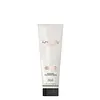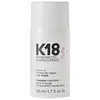What's inside
What's inside
 Key Ingredients
Key Ingredients

 Benefits
Benefits

 Concerns
Concerns

 Ingredients Side-by-side
Ingredients Side-by-side

Water
Skin ConditioningCetearyl Alcohol
EmollientBehentrimonium Chloride
PreservativeIsohexadecane
EmollientPropanediol
SolventGlyceryl Stearate
EmollientParfum
MaskingCoco-Caprylate/Caprate
EmollientPhenoxyethanol
PreservativeDiheptyl Succinate
EmollientNeopentyl Glycol Diheptanoate
EmollientCetrimonium Chloride
AntimicrobialTriheptanoin
Skin ConditioningIsopropyl Alcohol
SolventC13-14 Isoparaffin
EmollientIsododecane
EmollientHydroxypropylgluconamide
HumectantHydroxypropylammonium Gluconate
HumectantHydroxyethylcellulose
Emulsion StabilisingDisodium EDTA
Hydroxypropyl Guar
Emulsion StabilisingButylene Glycol
HumectantOryza Sativa Extract
AbsorbentHydrolyzed Vegetable Protein
Skin ConditioningHydrolyzed Rice Protein
Skin ConditioningCitric Acid
BufferingCapryloyl Glycerin/Sebacic Acid Copolymer
Skin ConditioningAloe Barbadensis Leaf Juice
Skin ConditioningIodopropynyl Butylcarbamate
PreservativePotassium Sorbate
PreservativePanthenol
Skin ConditioningTocopherol
AntioxidantChenopodium Quinoa Seed Extract
Skin ConditioningDaucus Carota Sativa Root Extract
Skin ConditioningGlycine Max Seed Extract
Skin ConditioningPanax Ginseng Root Extract
EmollientLinalool
PerfumingLimonene
PerfumingWater, Cetearyl Alcohol, Behentrimonium Chloride, Isohexadecane, Propanediol, Glyceryl Stearate, Parfum, Coco-Caprylate/Caprate, Phenoxyethanol, Diheptyl Succinate, Neopentyl Glycol Diheptanoate, Cetrimonium Chloride, Triheptanoin, Isopropyl Alcohol, C13-14 Isoparaffin, Isododecane, Hydroxypropylgluconamide, Hydroxypropylammonium Gluconate, Hydroxyethylcellulose, Disodium EDTA, Hydroxypropyl Guar, Butylene Glycol, Oryza Sativa Extract, Hydrolyzed Vegetable Protein, Hydrolyzed Rice Protein, Citric Acid, Capryloyl Glycerin/Sebacic Acid Copolymer, Aloe Barbadensis Leaf Juice, Iodopropynyl Butylcarbamate, Potassium Sorbate, Panthenol, Tocopherol, Chenopodium Quinoa Seed Extract, Daucus Carota Sativa Root Extract, Glycine Max Seed Extract, Panax Ginseng Root Extract, Linalool, Limonene
Water
Skin ConditioningAlcohol Denat.
AntimicrobialPropylene Glycol
HumectantCetearyl Alcohol
EmollientDicaprylyl Ether
EmollientCetyl Esters
EmollientBehentrimonium Chloride
PreservativePolysorbate 20
EmulsifyingSh-Oligopeptide-78
Hydrolyzed Wheat Protein
Skin ConditioningHydrolyzed Wheat Starch
Skin ConditioningIsopropyl Alcohol
SolventTocopherol
AntioxidantPhenoxyethanol
PreservativePotassium Sorbate
PreservativeCitric Acid
BufferingParfum
MaskingGeraniol
PerfumingLinalool
PerfumingHexyl Cinnamal
PerfumingBenzyl Alcohol
PerfumingWater, Alcohol Denat., Propylene Glycol, Cetearyl Alcohol, Dicaprylyl Ether, Cetyl Esters, Behentrimonium Chloride, Polysorbate 20, Sh-Oligopeptide-78, Hydrolyzed Wheat Protein, Hydrolyzed Wheat Starch, Isopropyl Alcohol, Tocopherol, Phenoxyethanol, Potassium Sorbate, Citric Acid, Parfum, Geraniol, Linalool, Hexyl Cinnamal, Benzyl Alcohol
 Reviews
Reviews

Ingredients Explained
These ingredients are found in both products.
Ingredients higher up in an ingredient list are typically present in a larger amount.
This ingredient is a preservative and often used for it's anti-static properties. You'll most likely see this ingredient in hair conditioners.
It does not cause irritation or sensitization in leave-on products at 1-5%.
Cetearyl alcohol is a mixture of two fatty alcohols: cetyl alcohol and stearyl alcohol. It is mainly used as an emulsifier. Emulsifiers help prevent the separation of oils and products. Due to its composition, it can also be used to thicken a product or help create foam.
Cetearyl alcohol is an emollient. Emollients help soothe and hydrate the skin by trapping moisture.
Studies show Cetearyl alcohol is non-toxic and non-irritating. The FDA allows products labeled "alcohol-free" to have fatty alcohols.
This ingredient is usually derived from plant oils such as palm, vegetable, or coconut oils. There is debate on whether this ingredient will cause acne.
Due to the fatty acid base, this ingredient may not be Malassezia folliculitis safe.
Learn more about Cetearyl AlcoholCitric Acid is an alpha hydroxy acid (AHA) naturally found in citrus fruits like oranges, lemons, and limes.
Like other AHAs, citric acid can exfoliate skin by breaking down the bonds that hold dead skin cells together. This helps reveal smoother and brighter skin underneath.
However, this exfoliating effect only happens at high concentrations (20%) which can be hard to find in cosmetic products.
Due to this, citric acid is usually included in small amounts as a pH adjuster. This helps keep products slightly more acidic and compatible with skin's natural pH.
In skincare formulas, citric acid can:
While it can provide some skin benefits, research shows lactic acid and glycolic acid are generally more effective and less irritating exfoliants.
Most citric acid used in skincare today is made by fermenting sugars (usually from molasses). This synthetic version is identical to the natural citrus form but easier to stabilize and use in formulations.
Read more about some other popular AHA's here:
Learn more about Citric AcidIsopropyl Alcohol is more commonly known as rubbing alcohol. It is most commonly used as a solvent, meaning it helps other ingredients dissolve.
This ingredient is an astringent alcohol. Astringent alcohols may also irritate skin as they high amounts may strip away your skin's natural oils.
Other types of astringent alcohols include:
According to the National Rosacea Society based in the US, you should be mindful of products with these alcohols in the top half of ingredients.
Any type of sanitizing product will have high amounts of alcohol to help kill bacteria and viruses.
Learn more about Isopropyl AlcoholLinalool is a fragrance and helps add scent to products. It's derived from common plants such as cinnamon, mint, citrus, and lavender.
Like Limonene, this ingredient oxidizes when exposed to air. Oxidized linalool can cause allergies and skin sensitivity.
This ingredient has a scent that is floral, spicy tropical, and citrus-like.
Learn more about LinaloolParfum is a catch-all term for an ingredient or more that is used to give a scent to products.
Also called "fragrance", this ingredient can be a blend of hundreds of chemicals or plant oils. This means every product with "fragrance" or "parfum" in the ingredients list is a different mixture.
For instance, Habanolide is a proprietary trade name for a specific aroma chemical. When used as a fragrance ingredient in cosmetics, most aroma chemicals fall under the broad labeling category of “FRAGRANCE” or “PARFUM” according to EU and US regulations.
The term 'parfum' or 'fragrance' is not regulated in many countries. In many cases, it is up to the brand to define this term.
For instance, many brands choose to label themselves as "fragrance-free" because they are not using synthetic fragrances. However, their products may still contain ingredients such as essential oils that are considered a fragrance by INCI standards.
One example is Calendula flower extract. Calendula is an essential oil that still imparts a scent or 'fragrance'.
Depending on the blend, the ingredients in the mixture can cause allergies and sensitivities on the skin. Some ingredients that are known EU allergens include linalool and citronellol.
Parfum can also be used to mask or cover an unpleasant scent.
The bottom line is: not all fragrances/parfum/ingredients are created equally. If you are worried about fragrances, we recommend taking a closer look at an ingredient. And of course, we always recommend speaking with a professional.
Learn more about ParfumPhenoxyethanol is a preservative that has germicide, antimicrobial, and aromatic properties. Studies show that phenoxyethanol can prevent microbial growth. By itself, it has a scent that is similar to that of a rose.
It's often used in formulations along with Caprylyl Glycol to preserve the shelf life of products.
Potassium Sorbate is a preservative used to prevent yeast and mold in products. It is commonly found in both cosmetic and food products.
This ingredient comes from potassium salt derived from sorbic acid. Sorbic acid is a natural antibiotic and effective against fungus.
Both potassium sorbate and sorbic acid can be found in baked goods, cheeses, dried meats, dried fruit, ice cream, pickles, wine, yogurt, and more.
You'll often find this ingredient used with other preservatives.
Learn more about Potassium SorbateTocopherol (also known as Vitamin E) is a common antioxidant used to help protect the skin from free-radicals and strengthen the skin barrier. It's also fat soluble - this means our skin is great at absorbing it.
Vitamin E also helps keep your natural skin lipids healthy. Your lipid skin barrier naturally consists of lipids, ceramides, and fatty acids. Vitamin E offers extra protection for your skin’s lipid barrier, keeping your skin healthy and nourished.
Another benefit is a bit of UV protection. Vitamin E helps reduce the damage caused by UVB rays. (It should not replace your sunscreen). Combining it with Vitamin C can decrease sunburned cells and hyperpigmentation after UV exposure.
You might have noticed Vitamin E + C often paired together. This is because it is great at stabilizing Vitamin C. Using the two together helps increase the effectiveness of both ingredients.
There are often claims that Vitamin E can reduce/prevent scarring, but these claims haven't been confirmed by scientific research.
Learn more about TocopherolWater. It's the most common cosmetic ingredient of all. You'll usually see it at the top of ingredient lists, meaning that it makes up the largest part of the product.
So why is it so popular? Water most often acts as a solvent - this means that it helps dissolve other ingredients into the formulation.
You'll also recognize water as that liquid we all need to stay alive. If you see this, drink a glass of water. Stay hydrated!
Learn more about Water